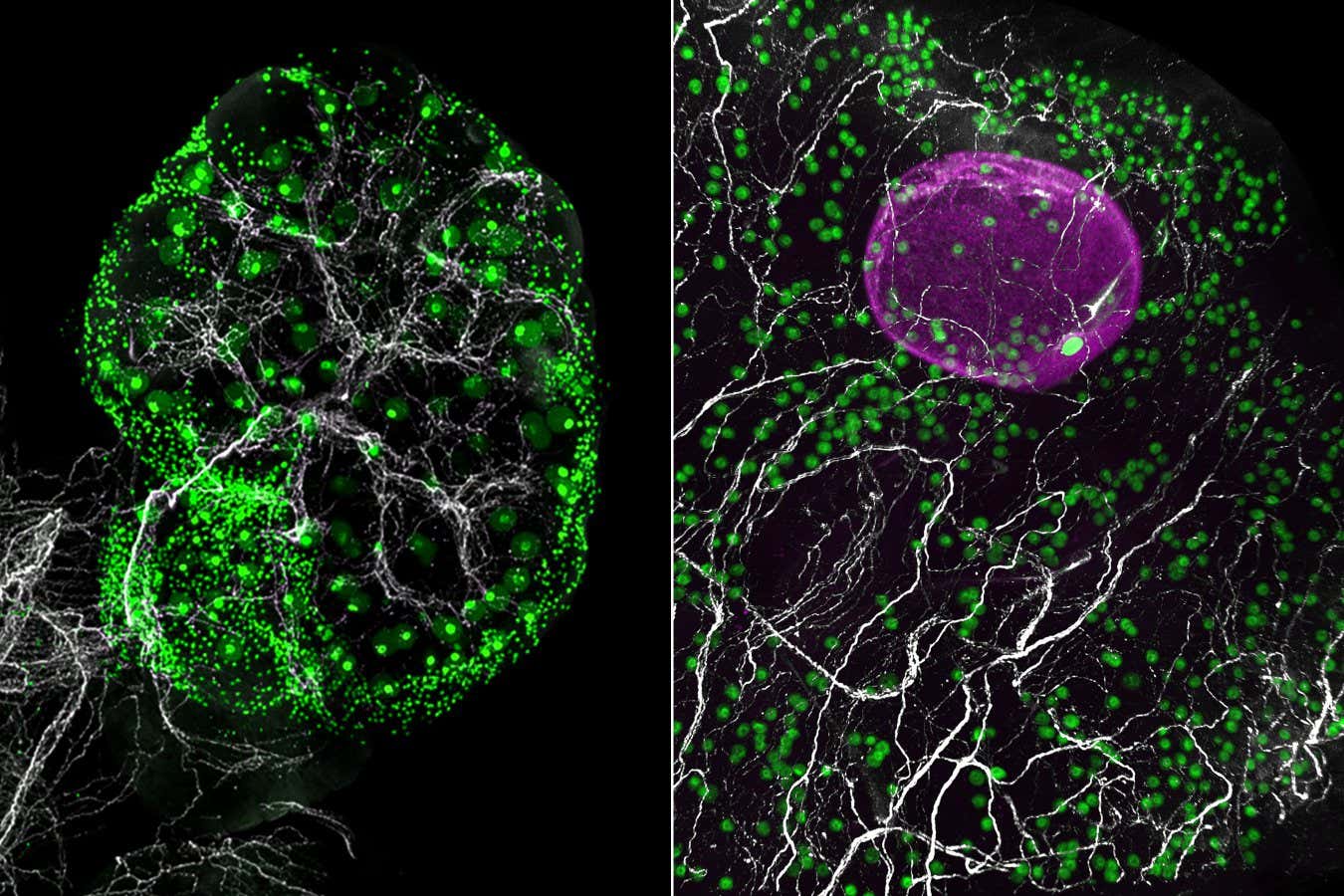
A network of nerves (white) throughout the ovary of a mouse (left) and in a fragment of human ovary (right), alongside eggs (green). A growing follicle containing an egg is shown in magenta
Eliza Gaylord and Diana Laird, Laird lab, UCSF
A new imaging technique has revealed a previously unexplored ecosystem within the ovary that may influence how fast human eggs age. The discovery could open new possibilities for slowing ovarian ageing, preserving fertility and improving health after menopause.
Women are born with millions of immature eggs, one of which fully matures each month after puberty. From their late 20s, however, fertility falls sharply – a decline long attributed to dwindling egg number and quality.
To better understand what drives this decline, Eliza Gaylord at the University of California, San Francisco, and her colleagues developed a 3D imaging technique that lets researchers visualise eggs without having to slice the ovary into thin layers, the standard approach.
These images showed that eggs aren’t evenly distributed, as we thought, but cluster in pockets, which suggests that the local environment within the ovary might shape how eggs age and mature.
By combining this imaging with single-cell transcriptomics, a technique that identifies cells based on the genes they express, the team analysed more than 100,000 cells from mouse and human ovaries. The samples came from mice aged between 2 and 12 months, and four women aged 23, 30, 37 and 58.
In doing so, the researchers found 11 major cell types, and a few surprises. One surprise was finding glial cells, which are normally associated with the brain – where they nourish neurons, clear debris and aid repair – as well as sympathetic nerves, which mediate the body’s fight-or-flight response. In mice whose sympathetic nerves had been removed, fewer eggs matured, suggesting that these nerves play a role in deciding when eggs grow.
The researchers also found that fibroblasts, cells that provide structural support, decline with age, which seemed to trigger inflammation and scarring in the ovaries of the woman in her 50s.
All this suggests that ovarian ageing isn’t simply about the eggs, but also about the whole ecosystem, says team member Diana Laird, also at UCSF. But the most important part of the study, she says, is seeing the similarities between mice and human ovarian ageing.
“The similarity lays the foundation for using laboratory mice to model human ovarian aging,” says Laird. “With that road map, we can begin understanding the mechanisms that maintain the rate of ageing in the ovaries so that we can develop therapies to slow or even reverse the process.”
One potential route, she says, is to modulate sympathetic nerve activity to slow the loss of eggs, potentially extending the reproductive window and deferring menopause.
Eggs (green) and a subset of growing eggs (magenta) in the entire ovary of a mouse at 2 months old (left) and 12 months old (right)
Eliza Gaylord and Diana Laird, Laird lab, UCSF
In theory, this would not only preserve fertility, but also reduce the risk of conditions that are more common after menopause, such as cardiovascular disease. “The possible downside of later menopause is increased risk for some reproductive cancers, but this is outweighed 20-fold by the odds of dying from post-menopausal cardiovascular conditions,” says Laird.
Such interventions are probably a long way off, however. Evelyn Telfer, at the University of Edinburgh, UK, whose team was the first to grow human eggs outside an ovary, points out that interpretation of the results is limited by the cell samples coming from just four women, with a relatively narrow age range. “Whilst the study is interesting, the findings are too preliminary to support therapeutic proposals aimed at altering follicle use or delaying egg loss,” she says.
Topics:
Source link : https://www.newscientist.com/article/2499537-hidden-ecosystem-of-the-ovaries-plays-a-surprising-role-in-fertility/?utm_campaign=RSS%7CNSNS&utm_source=NSNS&utm_medium=RSS&utm_content=home
Author :
Publish date : 2025-10-09 19:00:00
Copyright for syndicated content belongs to the linked Source.